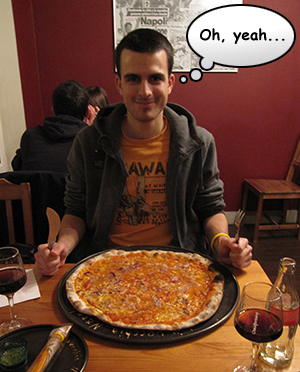 Though I have no time, nor the needed pictures, or real motivation to write a big post about my “new” Canyon Roadlite 7.0 racing bike, but I really would like to share some of my thoughts and memories about my first rides. I have learned a lot about my body and about cycling during the first 375 km. If you are not a cyclist, I think it is better to stop reading here, because it will not be interesting for an outsider… (Ok, I give you the “hungry Hungarian” right before he ate the best pizza in town… Yeah, you need a lot of power to ride!)
Though I have no time, nor the needed pictures, or real motivation to write a big post about my “new” Canyon Roadlite 7.0 racing bike, but I really would like to share some of my thoughts and memories about my first rides. I have learned a lot about my body and about cycling during the first 375 km. If you are not a cyclist, I think it is better to stop reading here, because it will not be interesting for an outsider… (Ok, I give you the “hungry Hungarian” right before he ate the best pizza in town… Yeah, you need a lot of power to ride!)
Let me start with the story of the maiden voyage. The bike was delivered (and assembled by me in the office) on the 5th of February, but due to harsh winter conditions (this winter was exceptionally snowy in Belgium), I had to wait until the 20th of February to be able to ride it back home from the University. After I rode it home, I went to Point2, a GPS shop in Leuven, where I bought a Garmin Edge 500 cycling computer (amazingly detailed review on the link, and make sure you check out the blog of the triathlete guy who wrote it, because it is really interesting). Yeah, I know, this is basically the 3rd GPS I own at the moment (and the 5th I bought overall), but I just do not care at all. Now I have a small, GPS-based cycling computer with a heart rate monitor and a speed/cadence sensor. So professional, that even the cyclists of the Garmin-Transitions Pro Cycling Team’s cyclists use it (because it is also compatible with professional power-meters). It is really cool :) But the coolest thing about it, that you can upload your workout data via a USB-cable to the Garmin Connect website, and have a really good overview about your ride. So it becomes very easy to track your progress. And being able to monitor your heart rate during the ride helps a lot to optimize the speed and intensity of the training. But back to the first ride. I wanted to check out some previously never used routes around Leuven, but it turned out to be a bad idea. First of all, some of the roads are really crappy, full of potholes, which makes the descents from small hills really unpleasant. (I was really surprised to find such hills here…) Because instead of just enjoying the speed downhill, you really have to concentrate on avoiding the potholes (and not getting hit by a car meanwhile doing it). Furthermore it was cold, and I got a flat. These things make a terrible situation when combined, because your winter cycling clothes only keep you warm when you ride, but as soon as you stop, you will have a cool feeling. Literally. Though it was beautiful, because I could see all the snow/rain showers around Leuven while I was standing in the sunshine (and 4°C), it was really cold… And this was the first time ever I had to change an inner tube, so I was not that fast. It took me almost 20 minutes, but I have seen too many YouTube videos about the procedure to have any difficulties at all. I just had to think a bit before every movement, to make sure I am not wasting the only spare inner-tube which I had in my saddle-bag. But everything went fine, and I was kinda proud of myself :) Yeah, this was my “first-time” :D But I did not want to risk another flat, so I just went home after this incident. Since then I have not only a spare tube, but a tube repair kit too in my saddle bag…
The next day (21st of February) I decided to ride on the cycle path along the canal to Mechelen and back, because I knew that the road is car-free and it has an almost perfect quality – so it is ideal for a fast training ride. It was right after I had a floorball league game with the Kraainem Tigers, so I was a bit low on power, but I really wanted to go… You can see the details of the ride here. (Click view in metric in the top right corner to have SI units…) In the first half, I had a slight tailwind, but I had not realized it before I turned back towards Leuven, and it started to blow right into my face… I was a bit surprised to see that I can (without any real difficulty) ride for two hours within a heart rate range of 170-182 BPM (HR Zone 4) which is the best training pace you need when you want to improve speed and anaerobic capacity. Due to the frame geometry and the drop handlebars, this bike is completely different from all the other bikes I have ridden in my life. Riding in the drops uses muscles I have never used during cycling before, so after this two hour ride I could barely move my hands for a while. I had pain in my arms for a couple of days… (And nothing in the legs, but that’s not so surprising…) Riding on the brake hoods on the other hands is quite the same as riding my single speed bike with the bullhorn bars, and the general feel is also very similar, so I had no trouble with that at all. But I definitely fell in love with the bike, I really like how fast and responsive it is… And weighting only 7.95 kg, it is so light, that after I carried it upstairs for the first time, my single speed bike felt shockingly heavy :D
On the 3rd of March I went cycling after work on the afternoon, then I went back and stayed until 10 PM in the office. (I am really happy to have flexible working hours.) This time I wanted to try new roads, so I downloaded a course from the Garmin Connect site, and loaded it into my Edge 500. This way, you can follow a route created by someone else, and you may even race against her/his time! Very motivating! And that’s exactly what I did. I was “in front” almost all the time, my virtual opponent took me over for 5 minutes only when I got a cramp in my left calf… I was standing in the turning lane on the N2 road, waiting for the cars to pass by or stop and let me turn to the south, but when it was clear, I started to push the pedals too hard, and I got the cramp… But it was not that serious, after ~3 minutes of flexing, I could continue my ride. Uphill… The most important things I have learned during this ride: 1) there are jerk SUV-drivers in Belgium too, honking at me even though they have more then enough space to pass me by; 2) small rural roads are generally smooth and perfect or terribly bad, but nothing in between. And the potholes are somehow always on the downhill side making sure you won’t be able to enjoy the “easier” part of the hill… I am a bit sad, because the data of this workout just disappeared from the memory somehow…
After the previous day, I was a “bit” sick and tired of the potholes, so I decided to stick to the well known cycling paths along the Dijlekanaal on the 4th of March. (The schedule was the same as on the day before: working, cycling, working.) The goal was clear – to go further and faster than the last time. Lesson of the day: sidewind is not that bad, because it has almost no effect on your speed. Though when you have sidewinds of 20 km/h, it can be quite uncomfortable… And here are the details of the ride. I met only slower cyclists, so I could not use their slipstream to rest. But they were too slow, so they could not hold my speed and use mine either ;) And something else: I was so hungry after the ride of the previous day, that I had to eat a slice of a pizza for breakfast, then I had a warm meal for lunch, and a warm meal for dinner too :) Plus a 100g of chocolate during the day and 2 energy bars during the ride, etc. You have to eat a lot as a cyclist… (Other usual food nowadays: fried eggs – and old classic has returned to my menu!)
On Sunday (7th of March) I had to be very careful in Mechelen, because there were a lot of people enjoying the sunshine with their dogs and/or small children, sometimes walking in the middle of the cycling path… The wind was even stronger than on Thursday (and it was cold), but it was still from the side most of the time. (See the details here.) I had headwind only near the northernmost part of the ride, where the Dijlekanaal ends (there is a large open area there without any trees which could block the wind). There it was really hard sometimes… I brought my compact camera with me, because I wanted to take pictures of the bike, but the lights were not the best, so I took only one…
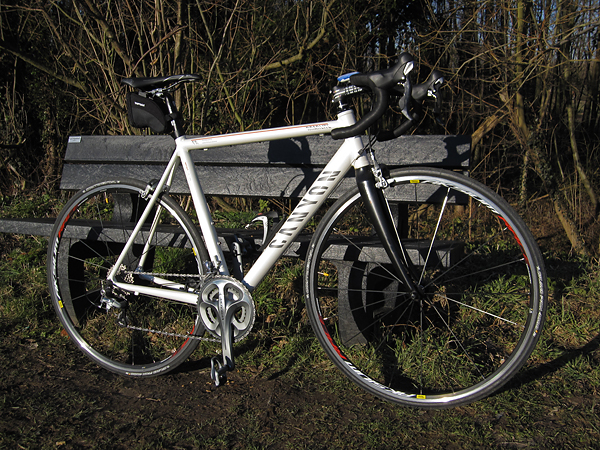
Next week (so last week) I went cycling twice, riding the same standard training route between Leuven and Mechelen on both days. On the 9th of March I had sidewind again. (Yeah, it started to get really boring.) The only one interesting thing about this day, that I finally met a cyclist, who was riding with my speed. Which means it was extremely hard to close the gap between us, without pumping my heart rate up to the sky. From the point when I saw him for the first time, it took me 5 km to catch up with him. But as soon as I started to ride in his slipstream, my heart rate dropped from 184 BPM to 168 BPM even though we raised the speed to 34 km/h from 32 km/h. It was a huge change. It become so much easier, I could even change to a bit more upright – less aerodynamic – position (from riding in the drops to riding on the hoods). After 2 km I went in front of him to give back the favor, so my HR jumped back to 180 BPM, but I could easily keep the pace of 34 km/h. After 1.5 km we went to different directions, so I had to fight the drag alone… Other details are here.
On Saturday (13th of March), I could finally experience the difference between headwind and tailwind. I had to ride against a headwind of 13 km/h in the first half of the training, then I had the same wind as a tailwind in the second half. As a result, my average speed was ~27.5 km/h in the first half, and ~35 km/h in the second (stops at crossroads included – see those downward spikes in the speed), with only a slightly higher cadence (83/87 RPM) and heart rate (175/180 BPM).
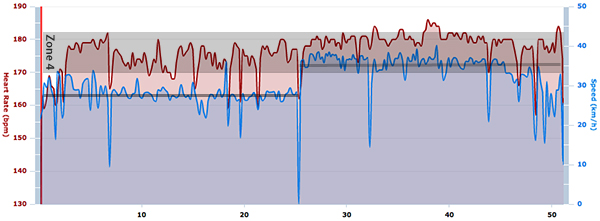
And it felt even easier to maintain these higher values. I think it is partly a psychological effect, as riding fast in tailwind gives a really pleasant (or even mesmerizing) feeling, so I am sure that the adrenalin level also raises in the meantime. I really enjoyed the speed! (See the details here.)
Conclusions: I really enjoy this bike, and I love the Garmin Edge 500!
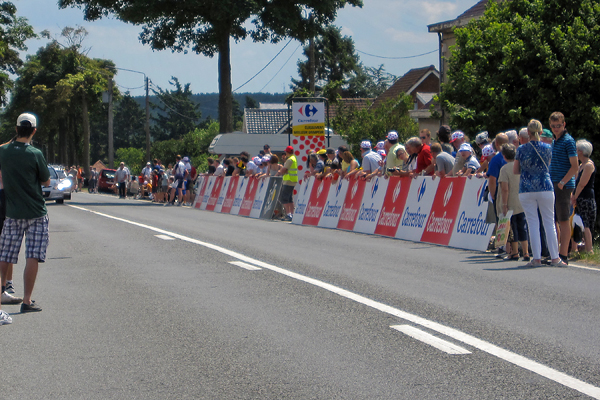
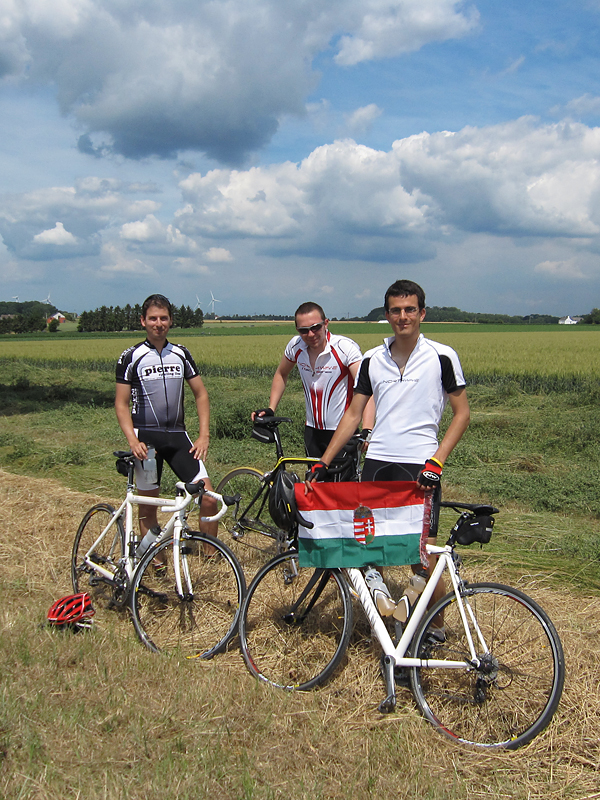
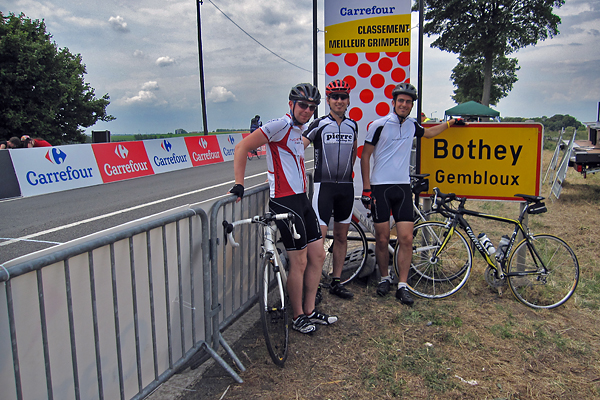
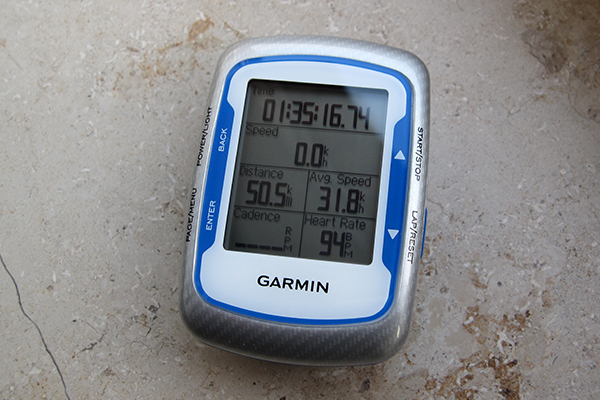
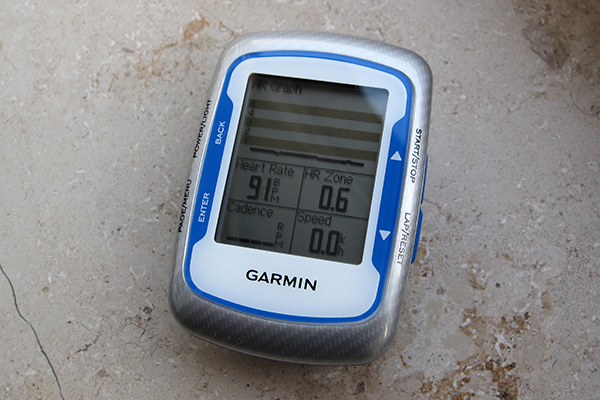
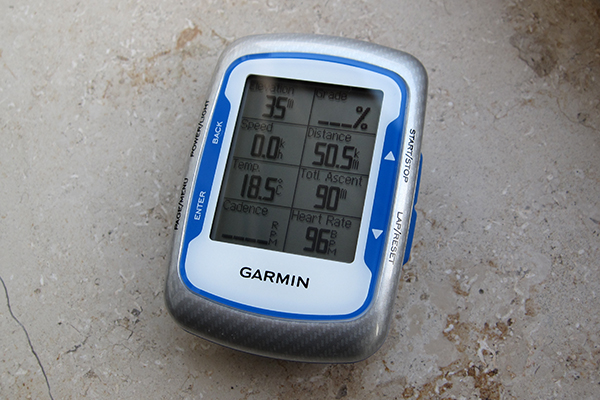
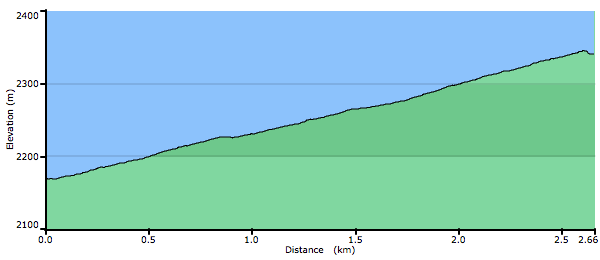
 Though I have no time, nor the needed pictures, or real motivation to write a big post about my “new”
Though I have no time, nor the needed pictures, or real motivation to write a big post about my “new” 
